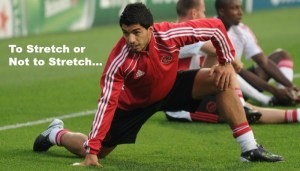Static vs. Dynamic Warmups: The Dilemma
Static vs. Dynamic Warmups: The Dilemma
by Kelly Sisley, MS, NSCA-CPT, CSCS, HHP Doctoral Student
Did you stretch? This is a question that most athletes have heard at some point in their career, but one that has become increasingly scrutinized over the last decade. Historically, coaches and athletic trainers have suggested static stretching before practice and competition to limit injuries. However, as the result of research published over the last decade, many coaches and athletic trainers have shifted to favor a more dynamic style of stretching. An athlete twenty years ago may have jogged a few laps around the field and then stretched for 10-15 minutes before his or her event; whereas, today an athlete is more likely to complete a series of increasingly dynamic movements designed facilitate an increased competition state. According to literature and popular practice, which method is more effective? Or is a combination of both methods the best?
Mikolajec and colleagues (2012) examined the effect of dynamic versus static stretching before performance in male basketball players. The authors found that a dynamic warmup prior to testing lead to an increased vertical jump performance; whereas, static stretching prior to testing had no significant effect. The idea that static stretching does not aid in performance is not new. McMillian and colleagues (2006) demonstrated that between no warmup, static stretching, and a dynamic warmup, only a dynamic warmup had a positive effect on athletic performance. The authors tested 30 cadets in the t-shuttle run, medicine ball throw, and the five step jump. Only when preforming a dynamic warmup prior did the authors see a significant improvement in performance (McMilian et al. 2006). In fact, static stretching and no warmup prior to participation resulted in the same results (McMillian 2006). Therefore, suggesting that static stretching prior to an event is the same as walking onto the field cold! These findings are consistent with the National Strength and Conditioning Association’s (NSCA) stance on static versus dynamic warmups. The NSCA (2008) has published research indicating that the static stretching before competition inhibits the stretch shortening cycle which can result in a decreased performance. However, while static stretching may inhibit performance, does static stretching aid in injury prevention?
Stretching Review (2009) illustrated that deficits in range of motion (ROM) can lead to musculoskeletal injuries. Therefore, since static stretching has been shown to elongate muscle and improve ROM it should help prevent injuries (Stretching Review 2009). However, Zakaria, Kiningham, and Sen (2015) demonstrated that inclusion of static stretching as part of a dynamic warmup program did not result in a significant reduction in injuries. The authors evaluated 22 soccer teams and found no significant differences in injury rates between teams utilizing a dynamic warmup with static stretching versus teams than only used a dynamic warmup. Therefore, it can be postulated that static stretching does not aid in injury prevention as part of an acute regime prior to practice or competition.
However, one cannot discount the psychological impact of superstitions, where a great performance is replicated by repeating everything, including the warm up! Consequently, if an athlete had a great performance after static stretching during their warmup, odds are the athlete will adhere to static stretching for life. While science and superstition can affect a future coach’s warmup protocol, more often than not coaches value other coaches’ insight above all else.
References
- Baechle, T.R., Earle, R.W. (2008). Essentials of strength training and conditioning. Champaign, IL: Human Kinetics.
- McMillian, D. J., Moore, J. H., Hatler, B. S., & Taylor, D. C. (2006). Dynamic vs. static-stretching warm up: the effect on power and agility performance. Journal Of Strength & Conditioning Research (Allen Press Publishing Services Inc.), 20(3), 492-499.
- Mikolajec, K., Waskiewicz, Z., Maszczyk, A., Bacik, B., Kurek, P., & Zaj&acedil;c, A. (2012). Effects of stretching and strength exercises on speed and power abilities in male basketball players. Isokinetics & Sports Leadership, 20(1), 61-69.
- Stretching Review: A scientific review of the benefits, or lack thereof, of stretching. (2009). Journal of Pure Power, 4(1), 68-70.
- Zakaria, A. A., Kiningham, R. B., & Sen, A. (2015). Effects of static and dynamic stretching on injury prevention in high school soccer athletes: a randomized trial. Journal Of Sport Rehabilitation, 24(3), 229-235. doi:10.1123/jsr.2013-0114





